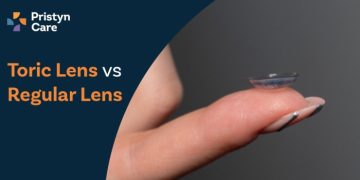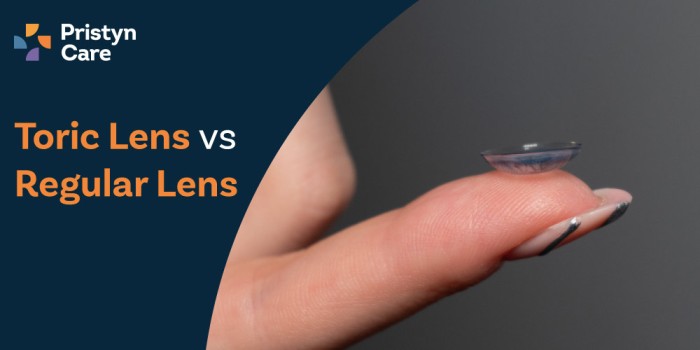![]() Views: 487
Views: 487
Toric Lens Vs Regular Lens
Are you wondering which type of contact lens is right for you? Choosing the right lenses can feel overwhelming, especially when faced with options like toric and regular lenses. What exactly is the difference between toric lens and regular lens?
Dedicated Support at Every Step!
Our Doctors are available 24 hours a day, 7 days a week to help you!
This distinction is crucial if you have astigmatism, as toric lenses are designed specifically to correct this condition, aligning with the unique curvature of your eye to provide clear, stable vision. Regular lenses, meanwhile, are typically used to correct common vision problems like nearsightedness or farsightedness.
In this article, we will break down the key differences between these two types of lenses, helping you decide which option best fits your visual requirements and lifestyle.
Table of Contents
What are Toric Lenses?
Toric lenses differ from regular spherical lenses in their shape. They have a design that creates different refractive, or focusing, powers on the vertical and horizontal orientations. This unique shape aligns with the irregular curvature of the eye seen in astigmatism.
Unlike spherical lenses that have a uniform surface, toric lenses are shaped more like a slice of a doughnut, with varying powers across their surface. This design helps them remain stable in the eye, crucial for their effectiveness.
How Do Toric Lenses Correct Astigmatism?
Astigmatism is caused by an irregular curvature of the cornea or lens in your eye, leading to blurred or distorted vision. Here’s how toric lenses help:
- Precise Orientation: They have a design that aligns with the specific curvature of your eye, correcting the way light enters your retina.
- Stability: Toric lenses must sit on the eye in a specific way to correct vision effectively. They are weighted at the bottom or have design elements that prevent them from rotating.
- Consistent Vision: The correct orientation and stability ensure that vision correction is constant and reliable, providing clear vision throughout the day.
Advantages of Using Toric Lenses
Using toric lenses comes with several benefits, particularly for those with astigmatism:
- Clearer Vision: They provide significantly clearer vision by specifically addressing the distortion caused by astigmatism, unlike regular lenses which may not fully correct such irregularities.
- Increased Comfort: Modern toric lenses are designed to fit comfortably on the eye and can be made from materials that allow high levels of oxygen to pass through to the cornea, promoting better eye health and comfort.
- Versatility: Toric lenses are available in various types, including daily, weekly, and monthly disposables. They are also available in tinted versions, which can enhance the appearance of your eye colour or assist in filtering UV light.
- Customisation: They are tailored to fit the unique shape of your eye, which means they can provide a more personalised and effective vision correction solution.
No Cost EMI, Hassle-free Insurance Approval
What are Regular Lenses?
Regular lenses, also known as spherical lenses, are designed with a uniform curvature across the entire surface. This means they have the same focusing power in all directions. They are simpler in design compared to toric lenses, which are shaped to correct astigmatism.
Regular lenses focus light onto a single point in the eye, improving vision for those with general refractive errors.
Common Uses and Limitations in Vision Correction
Regular lenses are primarily used to correct:
- Nearsightedness (myopia): This is when distant objects appear blurry. Regular lenses help focus the light further back in the eye.
- Farsightedness (hyperopia): This is when close objects appear blurry. Regular lenses adjust the focus forward, closer to the front of the eye.
However, regular lenses have certain limitations:
- Not Suitable for Astigmatism: They cannot correct astigmatism, which requires a lens that can compensate for the uneven curvature of the cornea.
- Limited Customisation: While they can correct the degree of nearsightedness or farsightedness, they do not address specific irregularities in the shape of the cornea.
- Visual Simplicity: They offer vision correction for straightforward refractive errors but might not provide the clarity needed for more complex vision problems without additional corrective measures, such as glasses or specialised contact lenses.
Comparing the Costs
Choosing between toric and regular lenses involves considering their cost differences and how they affect affordability.
Cost Difference Between Toric Lens and Regular Lens
Toric lenses typically cost more than regular lenses. This price difference stems from the specialised design and manufacturing process required for toric lenses. They need to have specific orientations and stability features to correct astigmatism effectively, which complicates their production. Regular lenses, with their uniform spherical design, are simpler and cheaper to manufacture.
The price gap between the two types can vary significantly depending on the brand, specific lens features like UV protection or moisture content, and whether they are daily, monthly, or extended wear options.
Insurance Considerations and Affordability
When considering the cost of lenses, it's essential to factor in insurance:
- Insurance Coverage: Many vision insurance plans provide a stipend or discount for contact lenses. The amount of coverage can vary, but typically, insurance will cover a portion of the cost of both toric and regular lenses. Checking with your provider is crucial to understand what is included in your plan.
- Annual Cost: Toric lenses might require a higher upfront investment, but the annual cost can be offset by insurance and the need for fewer lens purchases, as some toric lenses are designed for extended wear.
- Out-of-Pocket Costs: Depending on your insurance plan, the out-of-pocket costs for toric lenses can still be higher than for regular lenses. It’s wise to compare these costs annually to see how much more you might be paying for the benefit of correcting astigmatism.
- Affordability Options: Many suppliers offer payment plans or discounts for bulk purchases, which can make both types of lenses more affordable. Additionally, consider the long-term savings of choosing a lens that provides better vision correction and potentially reduces the need for other corrective measures.
Choosing the Right Lens for You
Selecting the best contact lens involves more than just your prescription; it's about matching your lifestyle and comfort.
Factors to Consider Based on Lifestyle, Severity Of Astigmatism and Personal Comfort
When choosing between toric and regular lenses, consider these factors:
- Lifestyle: Your daily activities can influence the best type of lens for you. If you engage in sports or outdoor activities, you might prefer lenses that offer UV protection and higher moisture content to maintain comfort.
- Severity of Astigmatism: The degree of your astigmatism is crucial in lens selection. Toric lenses are essential for moderate to severe astigmatism as they provide the precise correction needed for clear vision. For mild astigmatism, regular lenses might suffice.
- Personal Comfort: Comfort is key in wearing contact lenses. Some find toric lenses more comfortable because they correct their specific visual distortions, while others prefer the simplicity of regular lenses.
- Wearing Schedule: Consider how often you plan to wear your lenses. Daily disposables might be a convenient choice if you prefer not to clean and store them, whereas monthly or extended wear options could be more economical in the long run.
Importance of Consulting with an Eye Care Professional
It's vital to consult with an eye care professional for several reasons:
- Accurate Diagnosis: An optometrist can provide a precise assessment of your vision needs, ensuring you choose the right type of lens for your specific condition.
- Personalised Recommendations: Based on your eye health, lifestyle, and comfort preferences, they can recommend the most suitable lens type.
- Fitting: Especially for toric lenses, a professional fitting is essential to ensure the lenses perform correctly and comfortably.
- Follow-up Care: Regular check-ups help monitor your eye health and adjust your prescription as needed. They also prevent complications related to improper lens use.
Conclusion
Deciding on the right contact lens can be a clear-cut decision once you understand the difference between toric lens and regular lens. Toric lenses offer precision correction for those with astigmatism, ensuring sharp vision tailored to specific needs.
On the other hand, regular lenses provide a straightforward solution for more common vision issues like nearsightedness and farsightedness. Consider your daily activities, the severity of your vision problems, and personal comfort when making your choice.
Ultimately, a consultation with an eye care professional will guide you to the best option, ensuring optimal eye health and vision clarity. Whether toric or regular, the right lens awaits to enhance your daily life and vision.
FAQs
Q1. Are toric lenses better than regular lenses?
Toric lenses aren't necessarily better; they're specialised for astigmatism. If you have this condition, toric lenses will likely provide clearer vision than regular lenses, which correct simpler issues like nearsightedness or farsightedness.
Q2. Can toric lenses cause double vision?
Toric lenses typically aim to correct double vision caused by astigmatism. However, if they are not correctly fitted or have shifted, they might temporarily cause double vision. Ensuring proper fit and regular check-ups can mitigate this issue.
Q3. How many hours can you wear toric lenses?
The wearing time for toric lenses varies depending on the type and your eye health. Most are safe to wear for 8-10 hours. However, it's essential to follow specific guidance from your eye care provider to ensure comfort and eye health.
Q4. Are toric lenses more expensive than regular lenses?
Yes, toric lenses are generally more expensive than regular lenses. The additional cost is due to their specialised design, which corrects astigmatism more effectively than regular spherical lenses.









